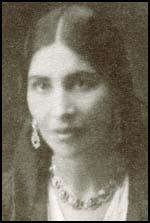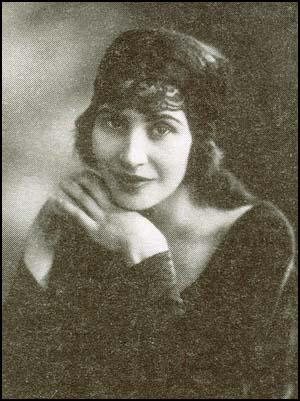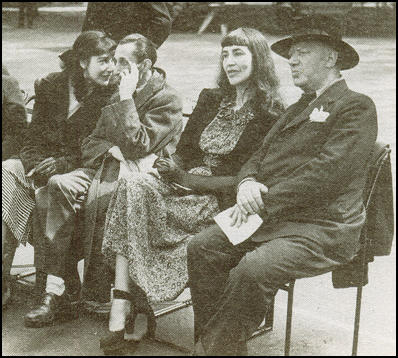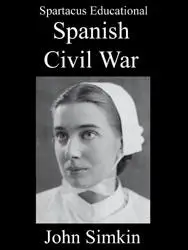Kathleen Garman

Kathleen Garman, the daughter of Walter Garman, the medical officer for Wednesbury, was born in 1901. Her mother, Margaret Magill, who was nearly twenty years younger than her husband, had eight other children: Mary (1898), Sylvia (1899), Douglas (1903), Rosalind (1904), Helen (1906), Mavin (1907), Ruth (1909) and Lorna (1911). The family lived at Oakeswell Hall, Wednesbury.
Kathleen later wrote about life in Oakeswell Hall: "It was... overrun with children and horses and pony and dogs and cats and rabbits and guinea pigs and cocks and hens - an old courtyard, surrounded by the house itself and all around the stables, the schoolroom, the laundry, an old malt house we called the bogey hole where we had three unsafe storeys of dirty and dusty old buildings for hiding and playing."
According to Cressida Connolly, the author of The Rare and the Beautiful: The Lives of the Garmans (2004), Kathleen was very close to her father: "Kathleen amused and charmed him. She was witty and clever, and she excelled at chess and the piano. As a party piece, he would invite local friends to play chess, setting each man at a table with a board and pieces before him. Then Kathleen, trained by her father and now under his proud gaze, would come into the room and go from table to table, winning every game."
Kathleen attended music lessons at the Birmingham and Midland Institute. She also went to art classes in Birmingham with her sister Mary. They also bought books and when Walter Garman caught them reading Madame Bovary, he summoned all the children and burned it on the fire in front of them.
In 1919 the two sisters rebelled and ran away to London. Kathleen took a job helping with the horses that pulled carriages for Harrods and also worked as an artist model, whereas Mary drove a delivery van for Lyons' Corner Houses. Dr. Garman was deeply shocked by this behaviour and eventually decided to give both his daughters an allowance, which enabled them to give up their jobs and enroll at a private art school called the Heatherley. This money also enabled them to rent a house in Regent Square.
Kathleen and Mary found themselves as part of the artistic set that gathered at the Café Royal. This included Percy Wyndham Lewis, D. H. Lawrence, Maurice Baring, Jacob Epstein, Augustus John, Virginia Woolf, E. M. Forster, John Maynard Keynes, Lytton Strachey, Roger Fry, Aleister Crowley and Nina Hamnett.
In August 1921 Kathleen and Mary were having dinner at the Harlequin when they became aware of a strange man who kept staring at them from the other side of the room. Cressida Connolly, the author of The Rare and the Beautiful: The Lives of the Garmans (2004), claims: "He was unkempt, with wild hair, but the intensity with which he regarded her, the concentration in his blue eyes, made her (Kathleen) unable to look away. Then a waiter brought over a note: would the women join the stranger's table? Kathleen was amused by the interest, but she and Mary left without accepting the invitation."

A few days later Kathleen was again back in the Harlequin. This time she was alone and she agreed to sit with the man. Jacob Epstein told her he was a sculptor and asked her to sit for him. He was forty years old and over the last few years had become a successful but controversial artist. In his first show he had sold £1,600 worth of bronzes. However, the naked figures which he made for the British Medical Association building in the Strand had caused a public outcry as they were considered by many to be indecent. The Risen Christ, produced as a result of his experiences in the First World War, also caused problems when it was exhibited in 1920. Epstein considered the figure to be an anti-war statement and declared that he would ideally like it to be remodelled and made hundreds of feet high as a "mighty symbolic warning to all lands." John Galsworthy remarked after visiting the exhibition that: "I can never forgive Mr. Epstein for his representation of Our Lord."
Kathleen not only become Epstein's model but his mistress. As Cressida Connolly has pointed out: "Mrs Epstein had always been tolerant of her husband's affairs, encouraging his models and mistresses to come and live with them, preferring to keep her enemies close... But Kathleen, nearly thirty years her junior, was different. She was never just another of Epstein's infatuations, whom Mrs Epstein could brush off after he'd finished sculpting them. She wasn't biddable. More than a lover, she was a parallel wife. From the beginning, Mrs Epstein disliked her intensely, rightly intuiting that she was to be her greatest rival."
Two months later Mary and Kathleen agreed to allow a friend, Stuart Gray, to live in the cellar of the house they were renting in London. One of his friends who came to visit him was the poet Roy Campbell. He later recalled: "When I saw her (Mary) I experienced, for one of the few times in my life, the electric thrill of falling in love at first sight."
Cressida Connolly has pointed out: "Within three days he had moved into the girls' studio room. Tall and thin, with startlingly blue eyes, he was already writing poetry, living on beer and forgetting to eat - or eating only radishes, their leaves and all, bought from a market stall. The girls decided to fatten him up, and the three of them would lie, arm in arm, in front of the fire while he read them fragments from the poems which would become his first book."
In December 1921 Roy Campbell was taken to Oakeswell Hall to meet their father, Walter Garman. Kathleen introduced him: "Father, this is Roy, who's going to marry Mary." Garman was furious as he did not approve of his future son-in-law. Not only was he unemployed, it was also clear that he had a serious drink problem.
Kathleen and Mary took Campbell to the Café Royal and introduced him to their friends such as Percy Wyndham Lewis, Jacob Epstein and Augustus John. Campbell recorded in his autobiography, Broken Record (1934): "No other contemporary woman ever had so much poetry, good, bad and indifferent, written about them, or had so many portraits and busts made of them."
Mary and Roy Campbell were married in 1922. The bride wore a long black dress with a golden veil whereas he put on his old suit. One guest observed that when he knelt at the altar he had holes in the soles of his shoes, padded with newspaper. Percy Wyndham Lewis was one of the guests at the wedding: "The marriage feast was a distinguished gathering, if you are prepared to admit distinction to the Bohemian, for it was almost gipsy in its freedom from the conventional restraints."
The marriage resulted in Kathleen and Mary drifting apart. The main reason for this was Campbell's right-wing political views. This resulted in a growing conflict between him and Jacob Epstein. Campbell had strong anti-Semitic views and in his autobiography wrote that the Jewish race was "intellectually subversive... that has none of our visual sense, but a wonderful dim-sighted instinct for dissolving, softening, undermining, and vulgarising."
Walter Garman suffered a heart-attack at Oakeswell Hall in May 1923. Kathleen was at his side when he died a few days later. The family believed that he had been killed by overwork, for he was only sixty-two. Garman also strongly disapproved of Kathleen's relationship with Jacob Epstein and she was left no money in his will.
In the summer of 1923 Margaret Epstein invited Kathleen to her home in Guildford Street when her husband was away. According to Cressida Connolly: "Mrs Epstein took Kathleen into a room and locked the door before producing a pearl-handled pistol from under her capacious skirts... and shot her. The bullet hit Kathleen just to the right of her left shoulder blade, whereupon Mrs Epstein panicked and ran out of the room, leaving the bloodied Kathleen to stagger out into the street alone."
Jacob Epstein visited Kathleen in hospital and paid her medical bills. Her shoulder was badly scarred and she was never afterwards able to wear sleeve-less dresses. She agreed not to bring charges against his wife as Epstein feared any scandal would damage his reputation.
In 1924 Kathleen gave birth to Theodore (Theo). Over the next five years she had two more children fathered by Epstein: Kathleen (b. 1926) and Esther (b. 1929). Throughout the 1920s Epstein came to stay with Kathleen two or three times a week. Even so, according to a letter he wrote at the time to Kathleen: "How I wish we were together you and I in our little place. How happy I would be beyond words and all expression in words."
On the outbreak of the Spanish Civil War in 1936, Garman wanted to join the International Brigade. However, as Peggy Guggenheim explained in her autobiography, Out of the Century (1979): "It was during the period of the Spanish War and he was very excited about it. I was afraid he was going to join the International Brigade, but his health would not permit."
Jacob Epstein also attempted to go but he was denied a visa. Lorna's boyfriend, Laurie Lee, did go in December 1937 but after spending a month at the training centre at Tarazona, a report concluded: "It seems clear that being, generally speaking, physically weak, he will not be of any use at the front. He agrees that the added excitement would be too much for him." Lee later commented: "I trained as a soldier, but I was mainly used in the International Brigade headquarters in Madrid during the siege, making short-wave broadcasts to Britain and America".

In March 1947, Jacob's wife, Margaret fell on the steps of her house and fractured her skull. She was rushed to hospital where she died from a brain haemorrhage. Kathleen rejected Jacob's suggestion that she went to live with him in Hyde Park Gate. Their son, Theo, was also an artist but he died of a heart-attack in January 1954. Their daughter, Esther, committed suicide nine months later.
Kathleen married Jacob Epstein in a small private ceremony at the Fulham Register Office in June 1955. Epstein wrote to a friend: "Yesterday Kathleen and I married. I had wanted this for a long time but Kathleen could not stand the publicity and so we had to resort to a ruse which completely dished all journalists and photographers and the event passed off quietly without the least fuss."
Jacob Epstein died of a heart-attack on 19th August 1959. Kathleen's friend, Rosie Price, argued that: "She devoted her life... to that man and his work. All Epstein wanted to do was work. Her life was almost a sacrifice to him, to his art."
In 1960 Kathleen befriended a young American poet, Samuel Menashe. He later recalled: "She was tall and she wore her hair straight down like a young girl and she had a slender figure. It was a strange contrast. She was fifty-nine then, with this old woman's face, but from the back she was like a ballerina, six feet tall. She was very hospitable and she loved parties. She loved elegant living. She had beautiful hands. If she peeled an apple... everything was done with an aesthetic sense. Nothing was brash."
In 1968 the American sculptor, Sally Ryan, bequeathed all her works of art and $50,000 in cash to Kathleen Epstein. This became the Garman Ryan Collection and in 1972 it was exhibited at Walsall Library.
Roland Joffe claimed that: "Kathleen wasn't all charm. People who are all charm don't stay in the mind. But combine that charm with a certain element of steel: that really works. That was what she was like."
Kathleen Garman died in August 1979.
Primary Sources
(1) Mary Dearborn, Peggy Guggenheim: Mistress of Modernism (2004)
Born in 1903 to a wealthy doctor and his wife (she was said to be half-Gypsy), he (Douglas Garman) grew up in an Elizabethan manor house called Oakeswell Hall in Wednesbury, near Birmingham in Staffordshire. Garman had a brother, Mavin, a farmer in Hampshire, and seven remarkable sisters, several of whom would figure in Peggy's life in the future. The beautiful Garman girls carried on a dizzying, decades-spanning roundelay of marriages and affairs with prominent men that would have left Alma Mahler envious. They included Mary, who married the fascist South African poet Roy Campbell and had an affair with Vita Sackville-West; Sylvia, who was said to have had an affair with the elusive T. E. Lawrence; Kathleen, the muse and mistress of Sir Jacob Epstein, the sculptor, who became his wife only after bearing him three children; Rosalind, who prosaically married a garage owner and had two children; Helen, who married a half-Norwegian fisherman in France and had a daughter, Kathy, who married the much-loved poet and memoirist Laurie Lee (whose Cider with Rosie was published in 1959); Ruth, who lived in Herefordshire and had several children by different men; and Lorna, perhaps the most beautiful of all, who married Ernest Wishart, the publisher who employed Douglas Garman, and bore him a child at seventeen, later had an illegitimate daughter with Laurie Lee (afterward her niece Kathy's husband), and later still had an affair with the painter Lucian Freud (who, in turn, later married and had a child with Kitty Epstein, another of Lorna's nieces, the daughter of Kathleen). Peggy was to consider all these Garmans as a kind of honorary family.
(2) Peggy Guggenheim, Out of the Century (1979)
Garman was the son of a family doctor who had had a large practice outside Birmingham. There he had lived in a big house with a garden, completely removed from the world, with his one brother and seven sisters. His father died while Garman was still at Cambridge, and Garman felt his loss very much and his early responsibilities of being head of the family. His mother was a gentle English lady living in retirement and great modesty. She was supposed to be the illegitimate daughter of Earl Grey, and indeed she looked aristocratic. She was so feminine and so ladylike she had always done exactly what her husband had wanted, and now, although she rarely saw Garman, she adored him and treated him in the same way. He had just bought a little house for her in Sussex near the downs and he intended to go down there for weekends...
Garman drove me to Sussex to show me the house he had bought for his mother. It was in a little English village called South Harting, just under the downs. The village was absolutely dead, like all such places in England, but it was in the midst of the most lovely country. Naturally, it had a fine pub. Garman also took me to see his sister Lorna and his brother-in-law, the publisher Ernest Wishart, whom he called Wish. They had a lovely home. Garman and Wish seemed to be the very best of friends, having been to Cambridge together. Wish's wife Lorna was the most beautiful creature I had ever seen. She had enormous blue eyes, long lashes and auburn hair. She was very young, still in her early twenties, having been married at the age of sixteen. Out of seven sisters, she was Garman's favorite. They were all extraordinary girls. One of them was married to a fisherman in Martigues, and another one had three children by a world-famous sculptor. Another lived in Herefordshire with her illegitimate child, while a fourth spent half the year as a maidservant in order to be able to live in peace the other six months in a cottage she had bought on Thomas Hardy's favorite heath. Later she adopted a little boy and was reported to have had a love affair with Lawrence of Arabia, whom she met on the heath, but when I knew her she was most virginal. Another one was married to the famous South African poet Roy Campbell. They were Catholic and later became Fascist and lived in Spain. One very normal one married a garage owner and led a happy life with two children. In his youth Garman must have been overwhelmed by so many women, and preferred not to see most of them any more. However, I was fascinated by them and eventually managed to meet them all. Garman had a younger brother whom he liked. He had returned from Brazil and was now farming in Hampshire.

